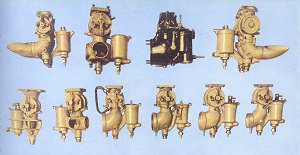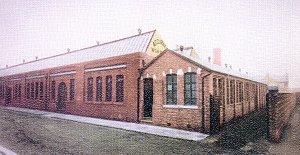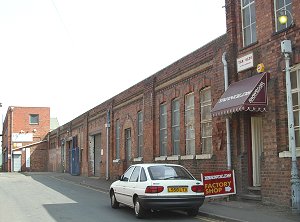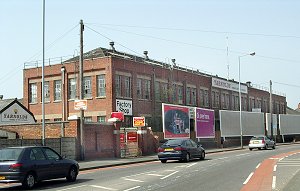H. M.
Hobson Limited,
Accuracy Works Limited,
Lucas Aerospace
| Hobsons was founded in 1903 as H M Hobson Ltd., by
Hamilton McArthur Hobson, George Cheeseman and Edward A. H. de Poorter.
It was originally an agency for selling bicycles. It was a London
based firm with registered offices at 36 Basinghall Street, EC,
works at Pelham Road, Wimbledon and, later, premises in Vauxhall
Bridge Road. |
|
 H. M. Hobson.
H. M. Hobson. |
Mr. de Poorter, who seems to have been a Belgian, lead them into the
motor trade. At that time the interest in and development of motor
transport was much greater on the continent than it was here.
Hobsons took up agencies for Mathieu and Dasse cars of Belgium.
They
did not sell many and Hobsons swapped to Decauville. They imported
chassis and fitted bodies to them. Hobsons found they sold well but
Decauville gave up making them in 1909.
Hobsons then got the agency
for Delahaye cars. Hobsons imported the cars but altered them
considerably for the UK market. They also sold well. |
|
In 1907 Hobson's exhibited the Nagant-Hobson car at the Olympia Show.
Whether this was their own design or another agency deal is not clear. But
these cars also seem to have sold quite well.
Through de Poorter they obtained an agency for Pognon spark plugs. These
seem to have been recognised as clearly the best on the market and were much
pirated. They were therefore re-named Pognon Hobson. Hobsons seem to have
started with an exclusive agency for the UK but later they got worldwide
distribution rights and annual sales started to amount to more than 120,000.
Hobsons also distributed Jenatzy Tyres and the Hobson "La Perfecta" non-skid
device.
In 1908, on a visit to France in connection with the
Pognon plugs, the directors met Claudel, a French engineer who was
making a car with his own design of carburettor. The carburettor seems to
have been demonstrably superior to existing types.
|
| Hobsons got
Claudel over to England and negotiated an agency and manufacturing
deal for his carbs. At first Hobsons main business was fitting these
carburettors to existing cars, replacing inferior originals. Later
they sold them to Sunbeam, Vauxhall and other car manufacturers. |

A collection of old Hobsons carburettors. |
|
The directors had a personal interest in flying and in 1909 Hobsons
advertised that they could supply Sommer's Aeroplane, for which they had,
presumably, yet another agency deal. In 1910 two of the directors fitted a
Claudel carburettor to a Wright biplane which they owned between them. They cast it
in aluminium, not the usual bronze or gunmetal, in order to save weight but
did not otherwise adapt it. This was their first venture into aircraft
carburettors.
So Hobsons started with a group of business men who had a good eye for a
good product and great skill at negotiating business deals. The company was
principally a sales organisation with a service department and a willingness
to try anything which might turn a profit. Their first big success was the
Claudel carburettors. These they imported from Claudel in France but soon they were
selling so many that Hobsons started making them in this country. Such was
the state of the art at the time that the work was given to a firm of
instrument makers.
|
 An old, heavily re-touched photo of the
original Accuracy Works.
An old, heavily re-touched photo of the
original Accuracy Works. |
In 1909 the French designer Louis Coatalen joined
Sunbeam in Wolverhampton. One of the first things he did was to
design a new engine which used the French Claudel carb.
The quantities Sunbeam needed could not be supplied by Hobsons.
But, Hobson's company history relates, "the Sunbeam company knew of
a small factory in Cousins Street which seemed suitable". |
| So a meeting was convened of Sunbeam directors
(Cureton, Coatalen, Iliff) and Hobsons (Hobson, Searight, Cheeseman,
de Poorter) "and a decision made to take over the Cousins Street
premises and form a small company, which was eventually registered
as Accuracy Works Ltd on May 9th 1911". It is not clear what part Sunbeam played in the Accuracy
company: they may have helped to finance it or they may simply have
given guarantees of orders. |

The original Accuracy Works as
they are in 2003. |

The interior of the old Accuracy Works, a
forest of drive belts. |
In 1912 James Montgomerie was appointed General Manager of
Accuracy Works and was there for nearly forty years. The
continuing success of the works is largely attributed to him.
His background is not known but he seems to have been a rough
diamond in the Edward Lisle mould. Bill Bradley, the works
foreman, said of him: "Mr. Montgomerie and me was the best of
friends. I had the sack six times a week! I once had the sack
for a fortnight - but he paid me for it". |
| At the outbreak of War in 1914 most of Accuracy staff
were sacked on the grounds that there would be no work for them
during the short duration of the war.
Hobsons then found there was a
profit to be made from a lengthy war, especially one in which the
forces were beginning to rely heavily on mechanised transport. They
expanded greatly, with Accuracy working round the clock.
Hobsons did their own development work on the Claudel
carburrettors which were used in Sunbeam-Coatalen aero engines, all
the Liberty engines from USA, and the Rolls Royce Eagle Falcon and
Hawk engines. |

A detail of the original
Accuracy Works. Its original builder and use are not known but
it was far from the basic factory design of its time. |
|
After the war the company continued its carburettor production, and
developed the Automatic Boost Control with Bristol Aero Engines. This was
fitted to the Bristol Pegasus engine, and led to the development of the
Hobson-Penn Automatic Mixture Control. From this start Hobsons finally
developed the sophisticated Master Control Injection Carburettor.
But they were still looking for new products and new opportunities. In
1919 they introduced the Hobson-Perfect Window Regulator, which was the
first wind up system for windows in cars, buses, coaches and railway
carriages etc. This seems to have been invented by Hobsons themselves and
was a market leader for decades. But it does not seem to have been made in
Wolverhampton.
In 1922 they acquired the right to make an American petrol gauge. It was
sold as the Hobson-K.S. Telegage. They developed this and adapted it to
gauges for oil pressure, water temperature, and battery water level and made
it in hydrostatic and electrical form. These gauges were widely used
throughout the British car industry and were later adapted for use in other
industries, such as the brewing, dairy and petroleum industries, to become a
major company product.
Sometime post war Hobsons decided to stop relying on the erratic M.
Claudel for design and development and engaged as consultant, and then
employed, Captain E. Dodson, who was there until his died in 1947. He seems
to have been responsible for most of the new ideas, innovations and designs.
These included the Hobson Master Control System which incorporated intricate
controls in the carburettor as one unit for maintaining engine boost
(induction) pressure and mixture strength at any pre-determined requirement
. "The first fully automatic carburettor was fitted to an Armstrong-Siddeley
Cheetah engine in the mid 1930s and so efficiently did it operate that it
was not long before the Accuracy Works were making large numbers in various
types suitable for Armstrong-Siddeley Motors, the Bristol Aeroplane Company
and later de Havilland".
In the post-war years Hobsons were associated with many car and plane
speed and endurance records and racing successes. In 1919 Alcock and Brown's
Vickers Vimy was powered by two RR Eagle engines with Hobson carburettors.
In 1927 Hobson moved all of their London operations to Acton Vale. At
that time they listed their products as: Claudel-Hobson Carburettors,
Hobson-Perfect Window Regulators, Hobson-KS Telegages, Belflex-Hobson Fabric
Spring Shackles and Engine Mountings, Hobson Sparking Plugs.
In 1935 what had been a private company was turned into a public company
called H. M. Hobson (Aircraft and Motor) Components Ltd. In effect
this was a holding company which owned:
H. M. Hobson Ltd.: basically the selling organisation for the
other two companies and makers of Hobson-K.S. Telegages and Hobson park
plugs
Floats Ltd.: who made the window regulators
Accuracy Works Ltd.: which made "the Hobson-Penn automatic mixture
control, Hobson induction pressure (boost) control, Hobson-Swan ice
eliminator, Hobson automatic ignition control, and the Hobson fuel pump and
control diaphragm" and everything made under the "exclusive licences of the
foreign patents right for Claudel-Hobson carburettors and controls".
|
 |
The factory expanded back from
Cousins Street to what is now the Birmingham New Road which this
large building (date unknown) fronted on to.
Its last use was
by Yarnolds (curtain makers) who moved out of all but a small part
at the rear several years ago. |
| This view was taken from the top
of the eastern end of the original Accuracy Works, looking towards
the Birmingham New Road. It gives some impression of the size
the factory eventually became. But it also shows that the
buildings suffered the usual fate of abandoned buildings and fell
prey to vandals, undesirables and the like. |
 |
 |
This photo, taken from the
Birmingham New Road and looking down one side of the Accuracy Works
site towards Cousins Street, again gives an idea of the eventual
size of the works. It also shows that, as with most factories of
this size, the development tended to be piecemeal, with new
buildings being erected as need arose.
The company also owned the Integral works
in Wolverhampton.
|
| When the Second World War broke out Hobsons, who anticipated that
London would be bombed, moved all of their works out of London to
Bridgwater and Coventry and Oldham. Their premises in Coventry were
then bombed out and all the work from there was transferred to
Wolverhampton.
Their products were in enormous demand for the war effort. Most
British aircraft had Hobson equipment. The Accuracy works were
working flat out, as were several shadow factories (other companies'
factories which were turned over to war work and authorised by the
government to make other people's products). The company history
also refers to "the relatively new Hobson factory adjoining the
Stafford Road at Fordhouses" as engaging in war work. Presumably
they had acquired their Stafford Road site sometime in the mid
1930s. The old Accuracy works had been expanded far beyond the
original premises in Cousins Street as far as what became the
Birmingham New Road. But when Hobsons left those premises is not
known.
|
|

